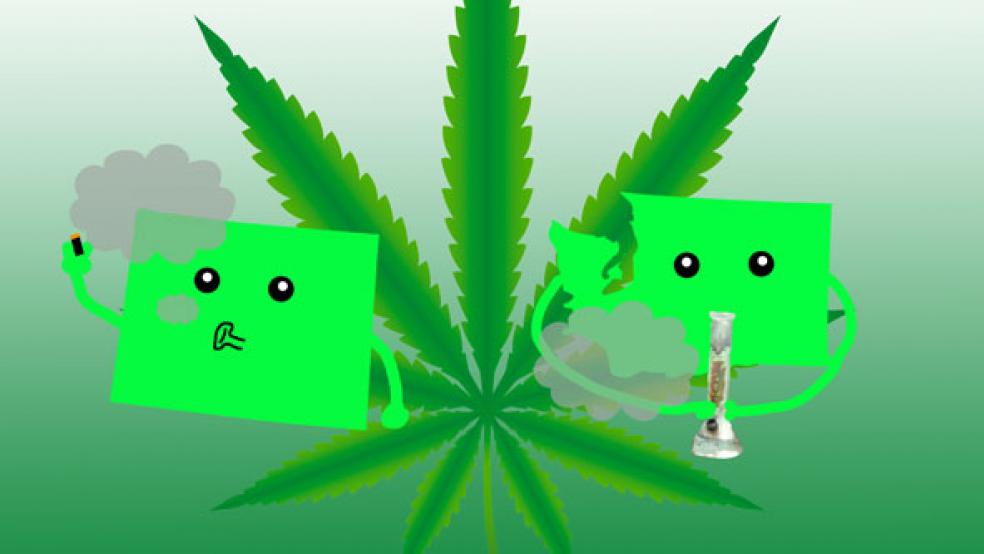These are high times in America for recreational marijuana users. On Tuesday night, two states – Colorado and Washington – passed historic measures to legalize using and selling small amounts of pot, effectively challenging the federal law that classifies the drug as an illegal narcotic.
In Colorado, adults 21 and older will now be able to legally buy and possess up to one ounce of cannabis and grow as many as six plants. In Washington, the measure authorized the state liquor control board to regulate and tax the drug.
RELATED: 5 Sinful Ways to Solve the Debt Crisis
“The voters have spoken and we have to respect their will,” said Colorado Governor and Democrat John Hickenlooper, who opposed the measure, in a statement. “This will be a complicated process, but we intend to follow through.”
A medical marijuana measure, which would legalize the practice for medicinal purposes only, also passed in Massachusetts. Including it, 18 states plus Washington, D.C., now have laws allowing the use of medical marijuana in some form.
While it may take some time for the remainder of the country to follow suit, there has been much debate over the costs and benefits of legalizing the drug. With state coffers running low, some wonder if it makes economically to flip arrests, fines and expensive incarceration into jobs, tax revenue and small businesses.
Either way, here’s a look at the numbers:
• 750,000 – The approximate number of people who are arrested every year in the U.S. for marijuana-related offenses. About 40,000 inmates of state and federal prison have a current conviction involving marijuana, most having to do with distribution.
• $14 billion – The estimated size of the marijuana market if it were to be legalized in the U.S., according to the 2010 Cato Institute paper The Budgetary Implications of Drug Prohibition, which could yield some $8.7 billion in tax revenues and enforcement cost savings.
• 1,000 – The approximate number of dispensaries California’s medical marijuana industry has created, generating sales of more than $3 million a year.
• $105 million – The amount that California’s medical marijuana industry generates in taxes each year.
• $40 – The price of an eighth of an ounce of cannabis in Humboldt County, California.
• $10-$20 – The hourly wage someone can make “budtending,” i.e., standing behind the counter at a dispensary to greet and help customers with their purchases. Other jobs available in the industry include receptionists, doctors, delivery drivers, trimmers, growers, chefs, and managers.
• $5,000 – The fee to obtain a Medical Marijuana Infused Products Manufacturing License in Denver, Colorado.
• $8-$10 – A one-cup container of pot-infused ice cream from the Mile High shop in Denver, Colorado, featuring such flavors as Vanilla Bud, Brown Sugar Cinnamon Pot Tart, and High Country Chocolate.
• $400,000 – The expected annual profits of a small 224-plant growing operation in the basement of a licensed marijuana grower in Colorado.
• $150 million – The estimated revenues of the medical marijuana industry in just manufacturing and equipment spending in 2010.
• $18.95 – The price of a paperback copy of Aunt Sandy’s Medical Marijuana Cookbook: Comfort Food for Mind and Body. Included are recipes for lemon bars, turkey with stuffing, buffalo wings, tomato bisque, chicken curry, and many more.
• $100 – The maximum fine in New York State for a first-time charge of possessing less than 25 grams of weed.
• $5,000 – The maximum fine for selling 25 grams to 4 ounces of pot in New York State. This is considered a felony and can result in up to 4 years in prison.
• $240,304 – Cost of 4 years of incarceration in a New York State prison ($60,076 a year).
• 82 percent – The proportion of the 50,000 people arrested in New York for small amounts of marijuana in 2011 who were black or Latino.



